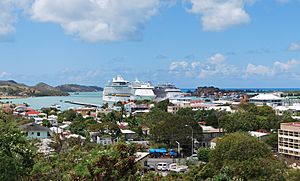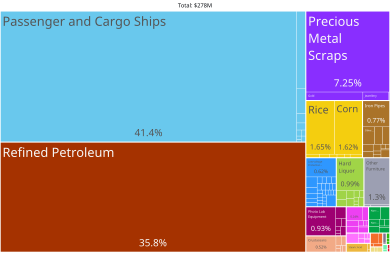Antigua and Barbuda facts for kids
Quick facts for kids
Antigua and Barbuda
|
|
|---|---|
|
Motto: "Each Endeavouring, All Achieving"
|
|
|
Anthem: "Fair Antigua, We Salute Thee"
|
|
 |
|
| Capital and largest city
|
St. John's 17°7′N 61°51′W / 17.117°N 61.850°W |
| Vernacular language | Antiguan and Barbudan Creole |
| Working language | English |
| Ethnic groups
(2020)
|
|
| Religion
(2020)
|
|
| Demonym(s) | Antiguan and Barbudan |
| Government | Unitary parliamentary constitutional monarchy |
|
• Monarch
|
Charles III |
| Sir Rodney Williams | |
| Gaston Browne | |
| Legislature | Parliament |
| Senate | |
| House of Representatives | |
| Formation | |
|
• Barbuda (Extension of Laws of Antigua) Act
|
23 September 1859 |
|
• Annexation of Redonda
|
26 March 1872 |
|
• Parish Boundaries Act
|
17 December 1873 |
|
• Associated statehood
|
27 February 1967 |
|
• Independence
|
1 November 1981 |
| Area | |
|
• Total
|
440 km2 (170 sq mi) (182nd) |
|
• Water (%)
|
negligible |
| Population | |
|
• 2022 estimate
|
|
|
• 2011 census
|
|
|
• Density
|
186/km2 (481.7/sq mi) |
| GDP (PPP) | 2023 estimate |
|
• Total
|
|
|
• Per capita
|
|
| GDP (nominal) | 2023 estimate |
|
• Total
|
|
|
• Per capita
|
|
| HDI (2022) | very high · 54th |
| Currency | East Caribbean dollar (XCD) |
| Time zone | UTC-4 (AST) |
| Driving side | left |
| Calling code | +1-268 |
| ISO 3166 code | AG |
| Internet TLD | .ag |
|
|
Antigua and Barbuda is an island country in the Caribbean region. It is located in the West Indies, between the Caribbean Sea and the Atlantic Ocean. The country is made up of two main islands, Antigua and Barbuda, which are about 40 kilometers (25 miles) apart. It also includes several smaller islands like Great Bird and Redonda.
Most of the country's population, around 97,120 people (2019 estimate), live on Antigua. The capital city and largest port is St. John's, located on Antigua. On Barbuda, the largest town is Codrington. These islands are part of the Leeward Islands in the Lesser Antilles.
Christopher Columbus explored the island of Antigua in 1493. He named it after a church in Spain. The British started a colony on Antigua in 1632. Barbuda was first settled in 1678. Antigua and Barbuda became part of the West Indies Federation in 1958. Later, they became an "Associated State" in 1967, meaning they managed their own internal affairs. On November 1, 1981, Antigua and Barbuda gained full independence from the United Kingdom.
Today, Antigua and Barbuda is a member of the Commonwealth of Nations. It is a constitutional monarchy, which means Charles III is the head of state.
The country's economy relies heavily on tourism, which makes up about 80% of its total economic activity. Like many island nations, Antigua and Barbuda faces challenges from climate change. These include sea level rise and stronger hurricanes. These changes can cause coastal erosion and make fresh water harder to find. Since 2019, Antigua and Barbuda has had no personal income tax. The country also has a program where people can gain citizenship by investing money.
Contents
What's in a Name?
The name Antigua comes from a Spanish word meaning 'ancient'. Barbuda comes from a Spanish word meaning 'bearded'. The island of Antigua was originally called Wadadli by the Arawak people. People still use this name today.
When Christopher Columbus sailed past in 1493, he might have named Antigua Santa Maria la Antigua. This was after a religious image in Spain. The "bearded" part of Barbuda's name might refer to the men who lived there or to the bearded fig trees found on the island.
How is the Country Governed?
Antigua and Barbuda is a unitary parliamentary democracy. This means it has one central government and a system where people elect representatives. The head of state is the monarch, currently Charles III. He appoints a Governor-General to represent him in the country.
The Governor-General also appoints a group of ministers, called the cabinet. This is done based on the advice of the Prime Minister. The Prime Minister is the head of the government.
The government has the power to make decisions and carry them out. Laws are made by the Parliament. Parliament has two parts:
- The Senate: It has 17 members. These members are chosen by the government and opposition parties, then approved by the Governor-General.
- The House of Representatives: It has 17 members. These members are elected by the people for five-year terms.
What is the Geography Like?
Both Antigua and Barbuda are mostly flat islands. Their land has been shaped more by limestone than by volcanoes. The highest point in the country is Boggy Peak on Antigua. It is 402 meters (1,319 feet) tall and is what's left of an old volcano.
The coastlines of both islands have many beaches, lagoons, and natural harbors. Coral reefs and shallow areas surround the islands. There are not many rivers because the islands do not get much rain. Both islands also have limited fresh groundwater.
About 25 miles (40 km) southwest of Antigua is a small, rocky island called Redonda. No one lives there.
How is the Country Divided?
Administrative Areas
Antigua and Barbuda is divided into six parishes and two dependencies.
- Parishes (all on Antigua):
* Saint George * Saint John * Saint Mary * Saint Paul * Saint Peter * Saint Philip
- Dependencies:
* Barbuda * Redonda Even though Barbuda and Redonda are called dependencies, they are important parts of the country.
Main Cities
Here are the ten largest cities in Antigua and Barbuda:
- Saint John's (22,634 people)
- All Saints (3,412 people)
- Liberta (2,239 people)
- Potter's Village (2,067 people)
- Bolans (1,785 people)
- Swetes (1,573 people)
- Seaview Farm (1,486 people)
- Pigotts (1,363 people)
- Parham (1,276 people)
- Clare Hall (1,273 people)
Islands of the Country
Here is a list of the islands that make up Antigua and Barbuda:
|
|
|
What is the Economy Like?
Tourism is the most important part of the economy. It makes up more than half of the country's total economic output. Antigua is known for its many fancy resorts, attracting high-end travelers.
Investment banking and financial services are also important. Big banks like Royal Bank of Canada (RBC) have offices there.
Farming in Antigua and Barbuda mostly produces food for the people living there. It is limited by not having enough water and a shortage of workers. Many people prefer to work in tourism or construction because the pay is better.
Manufacturing involves making things like bedding, handicrafts, and electronic parts for export. The country's economic growth depends a lot on how well the economies of other countries, especially the United States, are doing. Many tourists come from the United States.
Antigua and Barbuda also has a program that allows people to become citizens if they invest money in the country.
What About the Military?
The Royal Antigua and Barbuda Defence Force has 285 members.
What Languages are Spoken?
English is the official language of Antigua and Barbuda. However, many local people speak Antiguan Creole. The way people speak in Barbuda is a little different from how people speak in Antigua.
Related pages
- Antigua and Barbuda at the Olympics
- Antigua and Barbuda national football team
- List of rivers of Antigua and Barbuda
Images for kids
See also
 In Spanish: Antigua y Barbuda para niños
In Spanish: Antigua y Barbuda para niños














